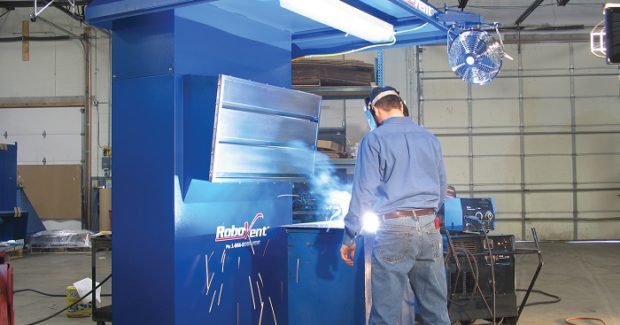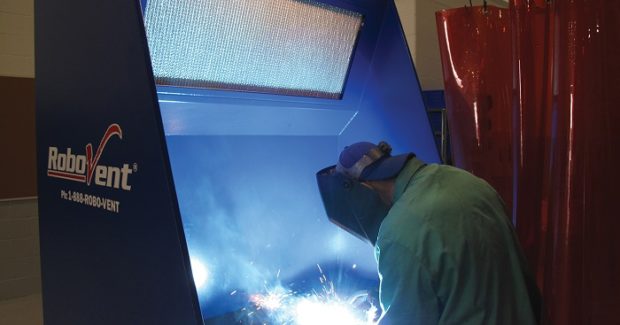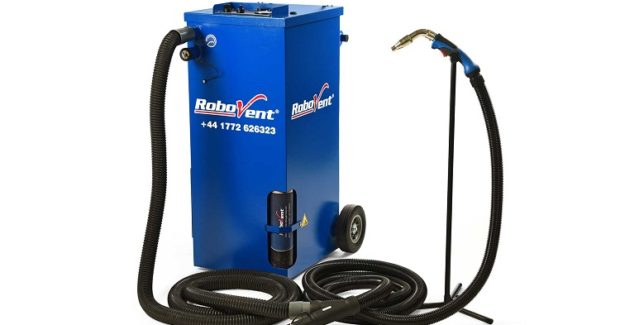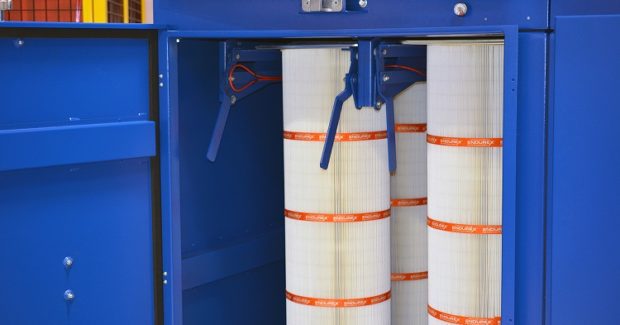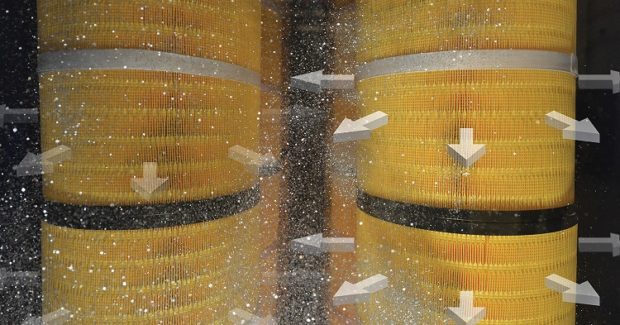Getting the Most from Your Clean Air Budget: Five Tips for Small Shops
Get past the initial equipment and installation costs and start thinking about total cost of ownership over time, including direct operating costs such as energy use, filters and maintenance, and indirect costs such as equipment downtime. Here are five ways a small shop can maximize their clean air budget and get more out of their equipment in the long run.
Posted: October 4, 2017
Doing business in today’s fast moving metal fabrication market requires tight margins and lots of flexibility. In this environment, it’s natural for manufacturers to look for ways to cut costs. But when it comes to air quality, cost cutting up front can lead to big problems later on. Air quality is not an issue that shops can afford to ignore: beyond potentially serious health impacts for workers, failing to keep weld fumes and other toxic particulates under OSHA permissible exposure limits (PELs) can result in expensive fines. And even moderately contaminated air is linked to higher levels of absenteeism, decreased productivity, poor worker morale and chronic health problems. Maintaining good air quality is the right thing to do, both morally and economically.
Small shops that are trying to keep their costs down may try throwing in some ventilation fans and calling it a day. However, this is not the best long-term solution for shop floors with significant particulate emissions from production. Evaluating air quality options requires looking beyond the initial equipment and installation costs and thinking about total cost of ownership over time. This equation includes direct operating costs such as energy use, filters and maintenance, and indirect costs such as equipment downtime. Here are five ways that small shops can maximize their clean air budgets and get more out of their equipment in the long run.
1. CAPTURE FUMES AS CLOSE TO THE SOURCE AS POSSIBLE
The first and most important rule in minimizing dust collection costs is to capture as close to the source as possible. The closer to the source you can capture the fumes as they are created, the less air you need to move for effective capture (measured in cubic feet per minute, or CFM). This means a smaller motor and blower and less energy consumption – some of the main drivers of dust collector costs. Shops should use source capture as a primary control mechanism wherever possible, including backdraft or crossflow tables, fume arms and fume guns. For robotic welding, hoods can also be used.
Fume guns require the least airflow because they capture fumes right at the weld seam, making them ideal for manual welding operations. They can be hooked up to relatively small and affordable hi-vac dust collector, some of which are also extremely portable for welders needing high mobility. For shops with a large number of manual welders or widely spaced welding stations, fume guns can also be ducted into one large centralized hi-vac dust collector. Fume arms and backdraft or crossflow tables are great for bench scale manual welding. They require more airflow than fume guns, but they offer advantages where welding position limits the effectiveness of the fume gun. Unlike fume guns, they also can collect dust from cutting and grinding.
If source capture is not possible due to the size of the weldments or physical constraints of the facility, ambient systems can be used to control air quality for the entire facility. These require significantly more CFM than source capture solutions. Shops can lower the costs of ambient air quality control by curtaining off or otherwise enclosing dust-producing applications to minimize CFM requirements. It’s important to remember that ambient systems will not keep fumes and dust out of the breathing zone for workers and may need to be paired with personal protection for workers directly exposed to weld fumes or dust.
2. MOVE TO FILTRATION TO SAVE ENERGY
Basic ventilation systems are always cheaper up front than filtration systems. However, they aren’t always cheaper over time. In most cases, proper ventilation requires outdoor air to be brought in from the outside to avoid negative air pressure inside the facility. Exhaust and makeup air systems continually push contaminated indoor air out (usually through the roof) and pull clean(er) outdoor air in. If you heat or cool your facility, this means indoor temperature air is exhausted outside and makeup air must be heated or cooled to indoor temperatures. Much like running your home furnace or air conditioner with the windows open, this places significant stress on HVAC systems and drives up energy costs. In areas with very cold winters or hot summers (or both), these costs can be significant.
As regulations for emissions continue to tighten, environmental concerns are another factor for exhaust and makeup air systems. Depending on the volume and makeup of your fumes, exhausting them to the outside could put your facility out of environmental compliance and expose you to fines. Finally, like any ambient system, ventilation systems won’t necessarily keep fumes in the breathing zone within safe limits. For these reasons, basic ventilation is best reserved for shops with minimal dust and fumes from production. For those with higher production, filtration systems can be a great energy saver over time and provide better protection for both workers and the environment.
3. SIZE YOUR EQUIPMENT CORRECTLY
When choosing a filtration system, correct sizing for the volume and type of fumes being produced is important. Along with CFM, the amount of filter media is a big driver of the initial cost of a dust collector. Collectors with greater area of total filter media cost more up front than those with less filter media. But from a total cost of ownership perspective, getting a dust collector that is too small for your applications is the wrong decision, because the money saved up front with a smaller collector will quickly get eaten up by increased consumable and energy costs.
The ratio of CFM to filter media for a dust collector is called the air-to-cloth ratio. In general, the higher your volume of particulates, the lower the air-to-cloth ratio should be (or, the more filter media you need for the airflow you are using). Without enough filter media, the collector gets clogged too fast, reducing effectiveness and driving up energy costs as the blower tries to move air though the loaded filters. This could mean changing filters every two weeks in a too-small machine, instead of once or twice a year. It’s not always easy to know what size dust collector you need for your applications. An experienced air quality systems designer can help you calculate the appropriate air-to-cloth ratio and find the dust collector that best balances up front and consumable costs over time.
4. LOOK FOR FILTER-SAVING FEATURES
Along with sizing equipment properly, look for technologies designed to extend filter life. Pulsing systems periodically blow dust off of the surface of the filters with a puff of air to prevent dust from getting embedded into the filter media, significantly extending filter life. The best systems use dynamic pulsing action to prevent dust from re-entraining onto neighboring filters. For example, our Dynamic Pulse™ system uses a rapid-fire, computerized pulsing system to remove 30 percent more dust than standard pulsing systems. Filters that are oriented vertically rather than horizontally in the dust collector cabinet also tend to last longer. While horizontal filters allow dust to settle on the top surface, gravity pulls dust down off of vertical filters.
5. LEVERAGE SMART, AUTOMATED CONTROLS
Automation of dust collection systems can save energy and reduce maintenance requirements. One simple form of automation for smaller shops are automatic start/stop systems that turn on and off with the weld torch, so they are only on when they are needed. This can save significant energy. These systems use arc sensing controls or voltage sensors to detect when the weld torch is turned on. The sensor drives a control system that turns the dust collector blower on or off with the torch. When multiple torches are ducted to a centralized collector, the control system can be used to close dampers to weld stations when they are not in use to reduce CFM and energy.
Variable frequency drive (VFD) is another simple form of automation available in many dust collector models. VFD automatically adjusts the blower speed for usage and filter loading. As filters become more loaded, it takes more energy to blow air through them. The VFD saves energy by keeping blower speed low when filters are new and increasing it as needed with filter loading. VFD will also automatically adjust blower speed for a centralized ducted collector as dampers are opened and closed with actual use.
Larger shops should consider even more sophisticated control systems that take advantage of emerging Internet of Things (IoT) technologies to enable centralized control of banks of dust collectors and more automation options. The most sophisticated of these can connect to air quality sensors to turn systems on and off based on real-time particulate levels and use machine learning to optimize system performance and maintenance schedules. Because these systems require some economies of scale, they may not be an option for smaller shops.





